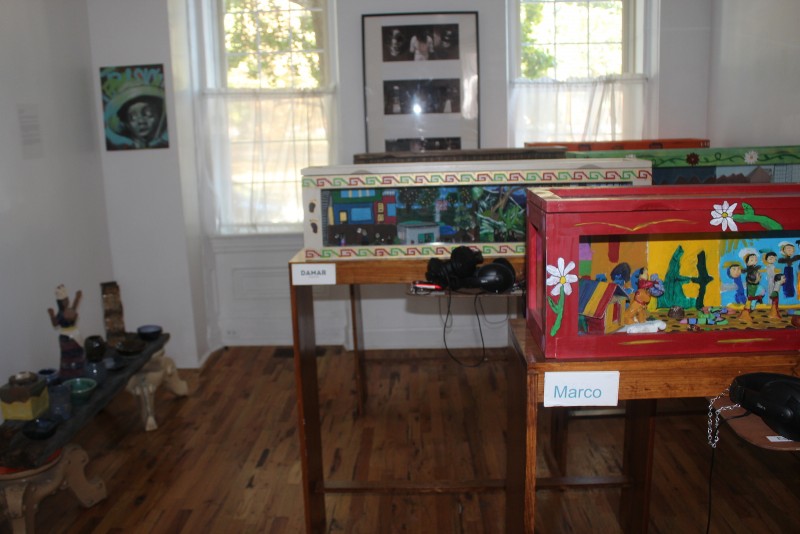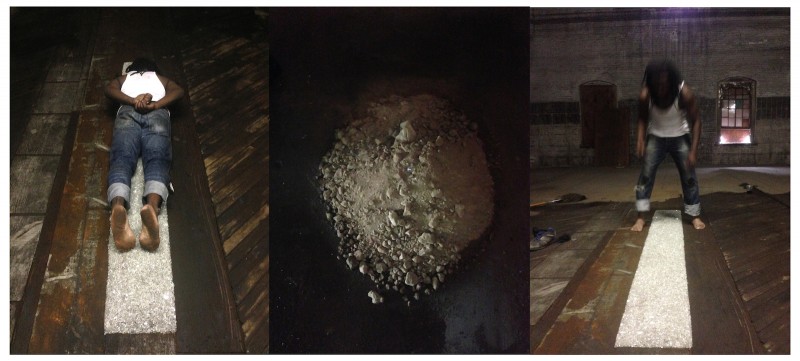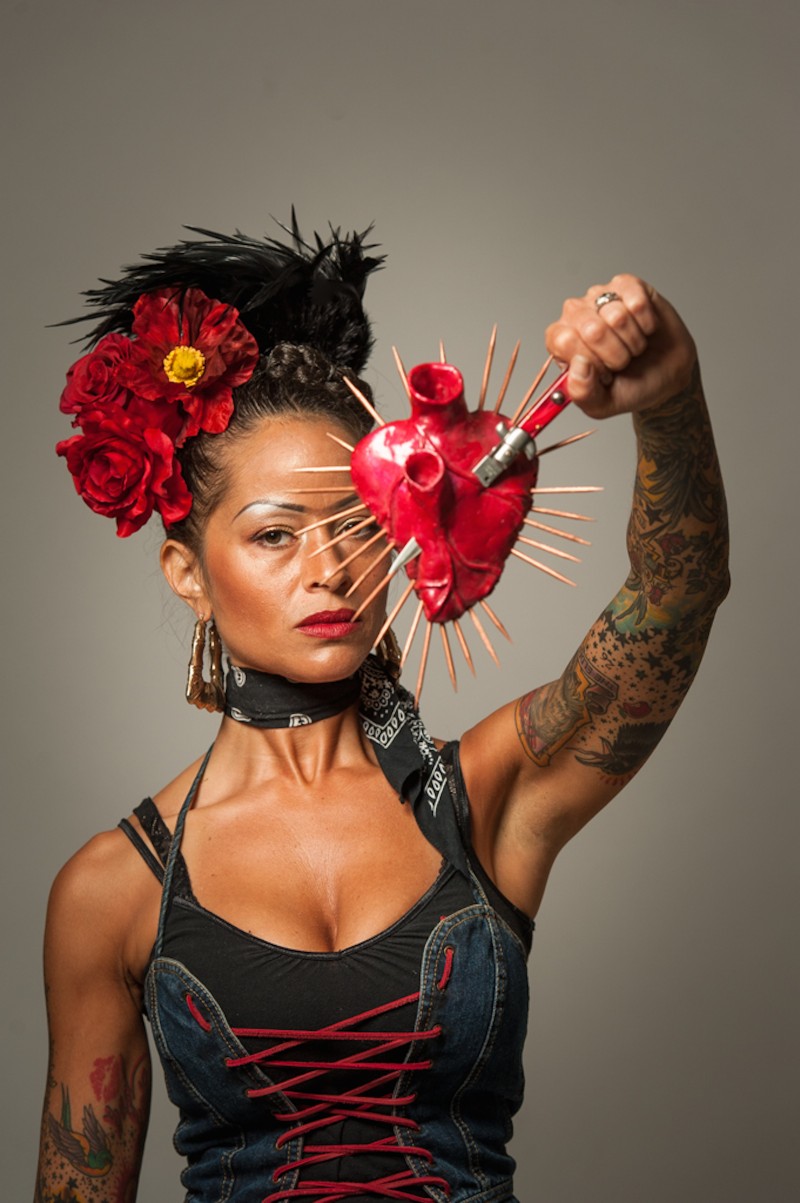In the Spirit of Gathering Spaces: Collectives, Collaborations and Initiatives at A Seed on Diamond Gallery gives a snapshot view of what’s going on with several grassroots artists and collectives in Philadelphia and New York. The featured works/installations are devoted to issues related to identity and social change. And no, identity for artists of color is a not a moot issue these days. Their perspectives on identity are as valid as those of Euro-American artists, who lay claim to universal truths as if they own them.
When entering the small gallery run by Betsy Casañas in the first floor of her home, I am immediately struck by the encased dioramas made by children who were border-crossers from Mexico to the USA.
Reliving a difficult journey

These fish tank-like displays are intricately designed with trims painted in bright colors. There are 10 dioramas in total and they consume most of the floor space in the gallery. Each display has a flash drive in the shape of a Swiss Army knife, replete with headphones, through which you can hear the voice of each child recounting their harrowing experiences.
El Viaje de Los Niños (The Children’s Journey) is a project initiated by Nora Litz, who has worked with youth traumatized by their immigration experiences. Litz and Michelle Ortiz started El Viaje as a collective in 2009. With familial ties to Mexico, both artists initially embarked on this art project to heighten public awareness of Mexican immigrants’ issues of assimilation and discrimination, while providing space and a voice for members of the community to disclose their stories. Litz took over the project in 2010, and for the past five years has created different iterations of El Viaje by engaging Philadelphia-based adults and children of the Mexican community in contextualizing their stories of trauma and subsequent adjustment through art.

El Viaje de Los Ninos is the collected stories of children from the ages of three to 17, who experienced the journey from Mexico to America and eventually landed in Philadelphia. Included in the current display are dioramas by one of the parents and the bus driver who transported the children from Mexico to America. Many of these children left parents, grandparents, and siblings behind to forge new lives in the States. The dioramas created under Litz’s guidance are made of clay, paint, and found objects, and visually reconstruct the children’s stories. One of the most compelling aspects of the project is the use of language in English and Spanish via audio recordings, in which the youth describe their journey to the United States.
Reverence represented
Other collectives and individuals with engaging installations in the show were Amber Art & Design, Young New Yorkers (YNY), and Bryan Karl Lathrop. Works by Amber Art and Lathrop are extraordinarily striking. Amber Art’s “El Nino” is a documentation of a recent public performance by collective member, Ernel Martinez, in a 10,000-square-foot warehouse that is part of the LaFrontera Project. LaFrontera is an art space inspired by bodegas in urban corridors, located at 8th and Susquehanna. The performance took place in early August 2015.

“El Nino”, which consists of three photo-triptychs entitled “baptism,” “the void,” and “bad hair,” evokes the holy trinity. The piece conceptually addresses issues pertaining to African-American men. The “baptism” includes an image of Martinez’s dreaded hair being used to mop up a dirty floor, while “the void” triptych shows Martinez as he prepares to lie on a bed of broken glass; a close-up of the glass; and him lying on the bed of broken glass. According to the artist, this segment of the performance represents the wanton arrest and incarceration of black men. The “bad hair” triptych toys with overarching notions about natural black hair amongst certain sectors of American society, and depicts two images of a wine fountain and one of the back of Martinez’s dreaded hair. The implication is of dirty hair, metaphor for the sins of the world, being washed clean in the well of the fountain–a symbol for the bloodletting of Christ through the crucifixion and subsequent atonement for the world.
The stark, sepia-toned images, with their loaded signifiers of hair, feet, white shirt, wine fountain, and broken glass, have metaphoric parallels to the trials of Jesus. The image of feet connotes washing the feet of the Christ and vulnerability; the white shirt is purity, according to Christian doctrine; glass is representative of trials and tribulations and the liquid in the fountain blood, possibly a metaphor for the blood of Christ. A direct display representative of the resurrection is missing, but is implied. There is a votive quality imbued in the works, through the repeated use of the wine fountain, that is most arresting.

“El Nino” also seems to be about language. The labels are written in English, Spanish and Garifuna.** Ernel Martinez’s family is from Belize and Honduras; however, he grew up speaking English only, because his family wanted him to become completely assimilated into the American experience. Traces of this history, the process of acclimation to America and related stereotypes as applied to blacks, as well as Christian/Catholic references, are implied in this work.
Beyond classification

Bryan Karl Lathrop is a self-taught Philadelphia photographer, who works with the collective AfroTaino Productions. (AfroTaino Productions programs musical events at different venues in Philadelphia and New York, such as Latin Roots Vivo at WorldCafe Live and the Barnes Foundation. This production company cultivates African-American and Latino audiences.) Lathrop creates rich and profound images using objects and portraits together in a triptych. An excerpt, Sabór, is part of a series based on the 2014-2015 NuevoFest in Philadelphia. A Frida Kahlo-like portrait of a woman holding a crimson heart with a knife through it alludes to the pains of love or dangerous matters of the corazón in general. Other images include the visage of the Aztec goddess Mictecacihuatl in honor of the deceased and perhaps representative of costumes donned during the Mexican celebration, the Day of the Dead. All of the photographs are intensely saturated with color, with red as the most predominant, conveying a sense of drama and intensity.
“Until You See Me” by Sheena Garcia features a hazy portrait of the face of a black boy behind a metal fence with graphic devices framing the image. This photo collage is intended to bring attention to the tendency of America to vilify the black male image. Possibly a response to the “Black Lives Matter” movement, the close-cropped image featuring the boy’s beautiful eyes and open face suggests friendliness and hope, in spite of the prison-like fence. This work is a sample of Garcia’s personal art statement. The artist has historically worked with intergenerational communities in the 12th and Spring Garden Street area of Philadelphia.
In The Spirit of Gathering Spaces has works that are so different it is hard to categorize them into one comfortable packet. Those that deal with identity issues offer a depth of information and symbols that transcend superficial discussions of race and class. The narrative aspect of the works ranges from the didactic to the abstract. For that matter, aren’t race and culture abstract and complex concepts in their own right? Discussions that present race and culture as a focus, like this exhibit does, offer a type of clarity about the human condition.
The goal of the Seed on Diamond Gallery is to function as an area for artists of color, and in particular, for artists from the surrounding Latino community to show a diversity of art disciplines. It’s a worthy goal and an important function. Be sure to put Seed on Diamond Gallery on your list of places to see art.
In the Spirit of Gathering Spaces: Collectives, Collaborations and Initiatives ran from Aug. 8-31 at Seed on Diamond Gallery, 124 W. Diamond St., Philadelphia PA 19122.
** The language of Garifuna (Carib) originated in the northern part of South America and spread throughout the Caribbean. Today, people of African descent speak Garifuna (Carib) in five Central American countries.









